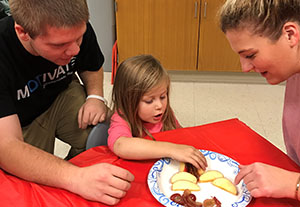 The opportunity to take newly learned information and immediately apply it in a research setting was priceless for Meghan Chemidlin.
The opportunity to take newly learned information and immediately apply it in a research setting was priceless for Meghan Chemidlin.
Last semester, the Elizabethtown College sophomore experienced, firsthand, milestones she’d just studied in her childhood developmental class as she took part in an Active Learning Lab with fellow occupational therapy (OT) students.
Crouched on the floor and at small tables with children—infancy to early elementary school—they made crafts, played and shared a snack. But the fun and games were far more than that. The students were studying the children’s fine and gross motor skills.
A simple game with colorful balloons became a peek into the children’s abilities levels. Stuffing cotton balls into containers exposed maturity. Ducking under a slowly unfurling parachute was an examination of movement.
It’s bridging between student and professional … professional development of personal self.”
As they interacted and observed, the OT students took considered the children’s verbal abilities—if they could understand instructions and give responses. Expectations were adjusted, accordingly, within the structure of the craft or game.
“Part of the major is having a back-up plan,” said Chemidlin. “You need to think on your feet.”
“Historically, we bring in kids for structured play,” said Nancy Carlson, associate professor of OT. These “active learning strategies” are a lot of what the sophomore OT-223 – Development and Occupations course is about. “How is a 2-year-old compared to a 4-year-old?” This interaction helps students learn which toy to match to which child and how to engage them, she said.
Katie Griest, marketing assistant in the Office of Marketing and Communications at Elizabethtown College, volunteered to bring her girls, Clara, 18 months, and Annie, 3 ½, to the lab. She participated to help the College, she said, and give her girls more experience interacting with people they don’t know.
They worked their ways through an obstacle course, took part in a dance session, made a craft and snacked. All the while, the students interacted, adjusting activities to correspond with the girls’ skills.
Griest said her younger daughter was initially a bit of a challenge for the students, but they found creative activity age adjustments. “It was real-life experience, showing (the students) if this is an age group they want to work with,” Griest pointed out.
Carlson said the OT students also study behavior at the Children’s Playroom of Lancaster County located at St. Paul’s United Methodist Church in Elizabethtown. Participation helps fulfill a 15-hour “community based learning” requirement.
The youngest child to participate in the E-town program was 9 months old, Carlson said. For some of the students it was the first time they held a baby. “This helps the students develop profession behavior, knowing how to be an OT and function as they interact with the family. It’s bridging between student and professional … professional development of personal self.”

